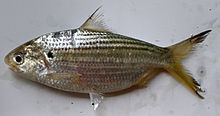
The flathead catfish, also called by several common names including mudcat or shovelhead cat, is a large species of North American freshwater catfish in the family Ictaluridae. It is the only species of the genus Pylodictis. Ranging from the lower Great Lakes region to northern Mexico, it has been widely introduced and is an invasive species in some areas. The closest living relative of the flathead catfish is the much smaller widemouth blindcat, Satan eurystomus.
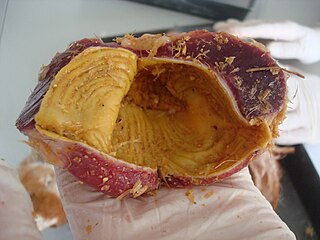
The gizzard, also referred to as the ventriculus, gastric mill, and gigerium, is an organ found in the digestive tract of some animals, including archosaurs, earthworms, some gastropods, some fish, and some crustaceans. This specialized stomach constructed of thick muscular walls is used for grinding up food, often aided by particles of stone or grit. In certain insects and molluscs, the gizzard features chitinous plates or teeth.
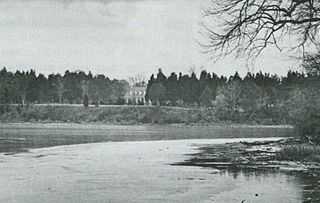
Pope's Creek is a 5.3-mile-long (8.5 km) tidal tributary of the Potomac River in Westmoreland County, Virginia. The George Washington Birthplace National Monument lies along the north side of Popes Creek. Popes Creek landing is located at 38°11′29″N76°54′16″W.
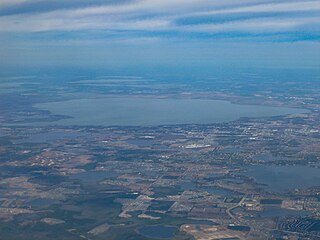
Lake Apopka is the fourth largest lake in the U.S. state of Florida. It is located 15 miles (24 km) northwest of Orlando, mostly within the bounds of Orange County, although the western part is in Lake County. Fed by a natural spring, rainfall and stormwater runoff, water from Lake Apopka flows through the Apopka-Beauclair Canal and into Lakes Beauclair and Dora. From Lake Dora, water flows into Lake Eustis, then into Lake Griffin and then northward into the Ocklawaha River, which flows into the St. Johns River.

South Holston Lake is located near the town of Abingdon, Virginia and the city of Bristol, Virginia / Bristol, Tennessee, and is a 7,580-acre (31 km2) impoundment operated by the Tennessee Valley Authority (TVA). Much of the reservoir is in Tennessee, but the Virginia portion of the reservoir offers anglers more than 1,600 acres (6 km2) of water. At this time there is a South Holston Reservoir Fishing License that will allow anglers from the two states to fish the entire lake with the purchase of this license.

Dorosoma is a genus that contains five species of shads, within the family Dorosomatidae. The five species are native to the North and/or Central America, and are mostly known from fresh water, though some may reside in the waters of estuaries and bays.

The American gizzard shad, also known as the mud shad, is a member of the herring family of fish, and is native to large swaths of fresh and brackish waters of the United States of America. The adult has a deep body, with a silvery-green coloration above fading to plain silver below. The gizzard shad commonly resides in freshwater lakes, reservoirs, rivers, and streams, but can reside in brackish waters, as it does on the Atlantic coast of the United States. Their range is across most of the continental United States, although they typically go no further north than New York and no further west than New Mexico. They are a large part of many of the ecosystems they inhabit, and can drive changes in phyto- and zooplankton, thereby indirectly affecting other planktivorous fishes. The gizzard shad has been widely used as a food source for game fish, with varied success in management and effectiveness.

The skipjack herring is a North American, migratory, fresh- and brackish water fish species in the herring family Clupeidae. The name skipjack shad comes from the fact that it is commonly seen leaping out of the water while feeding. Other common names include blue herring, golden shad, river shad, Tennessee tarpon, and McKinley shad. The skipjack shad is restricted to the Gulf of Mexico drainage basins. Skipjack are found in clear to moderately turbid water in areas with flow. Because they are a migratory species, dams often impede their reproduction. Records suggest that this species was much more abundant in the Upper Mississippi River basin before it was impounded. Currently, skipjack is most abundant in the Upper Mississippi River below the mouth of the Ohio River. They are known as an "early-run" species as they migrate to spawn in the early spring.

Tenualosa is a genus of fish in the family Dorosomatidae. When subfamilies are recognized, it is placed in the subfamily Alosinae or Dorosomatinae.
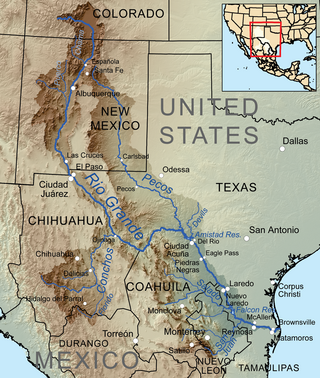
The Río Salado, also Río Salado de los Nadadores, or Salado River, is a river in northern Mexico, a tributary of the Rio Grande (Río Bravo). Its basin extends across the northern portion of Coahuila, Nuevo Leon, and Tamaulipas states.

The threadfin shad is a small pelagic fish common in rivers, large streams, and reservoirs of the Southeastern United States. Like the American gizzard shad, the threadfin shad has an elongated dorsal ray, but unlike the gizzard shad, its mouth is more terminal without a projecting upper jaw. The fins of threadfin shad often have a yellowish color, especially the caudal fin. The back is grey to blue with a dark spot on the shoulder. D. petenense is more often found in moving water, and is rarely found deep in the water column. It occurs in large schools, sometimes with gizzard shad, and can be seen on the surface at dawn and dusk. The threadfin shad may reach lengths of 8 in (200 mm), but only rarely. This fish is very sensitive to changes in temperature and dissolved oxygen, and die-offs are frequent in late summer and fall, especially when water temperature drops to 42°F. The threadfin shad is a favorite food for many game fishes, including striped bass, largemouth bass, smallmouth bass, and catfish. This fish is widely introduced throughout the United States as a forage for game fish.
Sardinella richardsoni is a species of ray-finned fish in the genus Sardinella from the South China Sea in the northwest Pacific.

Clupanodon thrissa, the Chinese gizzard shad, is a species of gizzard shad from the Northwest Pacific, occurring from Korea to Thailand and possibly the Philippines. It is the only species currently recognized in its genus.

Gonialosa is a genus of gizzard shads that are found in the rivers of South and Southeast Asia. There are currently three described species.
Konosirus punctatus is a species of fish in the family Dorosomatidae. It is the only member of the monotypic genus Konosirus. Its common names include dotted gizzard shad and konoshiro gizzard shad. It is native to the northwestern Pacific Ocean, where it occurs along the Asian coastline.

Nematalosa is a genus of gizzard shads in the fish family Dorosomatidae. There are currently 11 recognized species.
Starve Hollow State Recreation Area is a state recreation area in Vallonia, Indiana. The 280-acre (110 ha) recreation area was created from part of the larger Jackson–Washington State Forest. The area offers fishing, swimming, hiking, and a nature center.

The Bloch's gizzard shad, also known as gizzard shad, hairback, long-finned gizzard shad, long-ray bony bream and thread-finned gizzard shad, are a widespread and common, small to medium-sized anadromous fish found in all marine, freshwater and brackish waters throughout Indo-West Pacific, towards eastward of Andaman Sea, South China Sea and the Philippines to Korean peninsula. Single specimen recorded from waters of South Africa. It was described by Marcus Elieser Bloch in 1795.

Anodontostoma chacunda or Chacunda gizzard shad is a small species of gizzard shad found in both fresh and marine waters. The fish is from the family Clupeidae.
Nematalosa flyensis, the Fly River gizzard shad, is a species of freshwater ray-finned fish within the family Clupeidae. The species is endemic to Papua New Guinea, and is only known to inhabit the Fly and Strickland Rivers.
